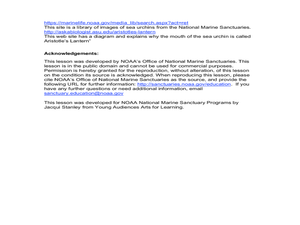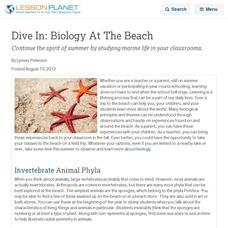Curated OER
Sea Urchins - Diadema Antillarum
Young scholars investigate oceanography by painting sea life. In this crustacean lesson, students identify sea urchins in our ocean environments and describe the functionality of their spherical-shaped bodies. Young scholars design their...
Curated OER
Pre-School
Young scholars draw their hand, and color their drawing. They count the number of fingure on thier hand. Students count the number of arms on the marine animal in the picture. They count the number of legs and claws on the marine animal...
Curated OER
Food Chains and Food Webs
Fourth graders study intertidal organisms and their role in the food web. In this food web lesson plan, 4th graders read the book The Sea That Feeds Us and discuss food webs. Students study pictures of intertidal creatures and discuss...
Curated OER
Activity Two: The Classic Fossil Lab-Simple Format
In this fossil worksheet, students are given a bag of fossils to identify. They use a key and a worksheet with pictures of the various types of fossils. They answer questions about fossils and use a web site to find out if their state...
Curated OER
Oddball Out: Seashore Creatures
In this science worksheet, learners analyze 4 pictures of seashore creatures in a row. Students circle the animal which is different from the others. There are 4 rows of pictures. Answers are provided upside down at the bottom of the page.
Curated OER
Monterey Bay Aquarium: One-Two-Three
In this counting activity, learners examine pictures of animals that live in the Monterey Bay Aquarium. They describe the animals by telling how many of a specified characteristic they have. Example: A sea otter has one tail.
Curated OER
Oddball Out: Sea Creatures
In this problem solving worksheet, students analyze a row of pictures of various sea creatures to determine which creature is different from the others pictured.
Curated OER
Who Am I? Tropical Plants and Animals
In this science worksheet, students examine 16 detailed pictures of tropical plants and animals. Students identify each species. There is no room to write the name under the picture. It is assumed this is an oral activity, although...
Curated OER
Oddball Out: Shells
In this problem solving worksheet, young scholars analyze a row of pictures of various shells to determine which creature is different from the others pictured.
Curated OER
Dive In: Biology At The Beach
Continue the spirit of summer by studying marine life in your classrooms.
New South Wales Department of Education
Invertebrates
Of all invertebrates, insects by far are the most numerous. Scholars discuss invertebrates and then use a key to classify them. They see different examples and must describe features of each organism based upon the key.
Curated OER
Fossil History
Learners examine the similarities and differences between living organisms and fossils. In this fossil activity students reenact the process of creating a fossil.
Curated OER
Embryology as Evidence of Evolution
Students observe the two major developmental pathways (protostome and deuterostome). They analyze data regarding differences in nucleotide sequences and construct a phylogenetic tree. They observe the similar evolutionary history shared...
Curated OER
What is an Animal?
In this animal worksheet, learners review characteristics of animals including body symmetry, development, and skeletal structure. This worksheet has 3 short answer questions.
Curated OER
Comparing and Contrasting
Learners practice compare and contrast skills. In this science and language development lesson, students complete a T chart generating traits of a snail and a clam. Learners complete a related worksheet.
Aquarium of the Pacific
Ecosystem Comparison
Fifth graders examine plants and animals in two ecosystems and compare them. In this ecosystem survival lesson, 5th graders compare and contrast a coral reef and kelp forest ecosystem. Students investigate the abiotic and biotic factors...

















